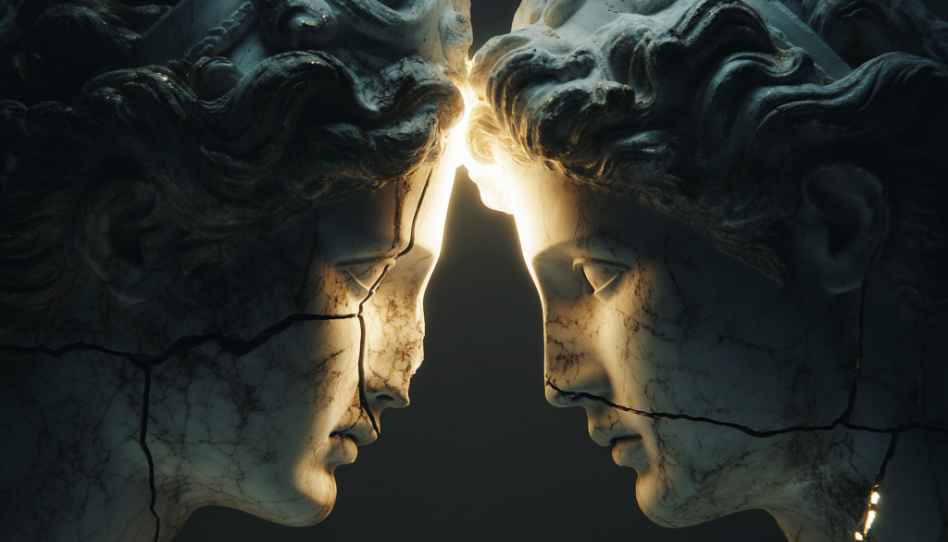Whatever anyone might tell you, the ancient Greeks were anything but innocent.
I grew up hearing the oft-used justifications for the nude sculptures of antiquity and assurances that they were innocent rather than prurient or even sexual. As a kid, I was skeptical of these justifications, but my doubts only grew as I grew older and read more Greek literature.
Sexual humor and references abound in Aristophanes’ Assembly Women, a play so lewd that the Victorian translation I initially picked up was excessively opaque as to purposely veil the original text’s meaning. Plato’s Symposium reveals the prevalence of sexual relationships between older mentors and young students. Metamorphosis is replete with tales of lust, adultery, and rape. Sexual exploitation of both women and men was rampant in both ancient Greek and Roman cultures. Distinctions exist between art and pornography.

Art vs. Pornography: Where Is the Line?
In light of these cultural trends, one would be hard-pressed to find evidence that nudity in Greek art was innocent. Despite this, one of the most common and seldom-questioned assumptions in the art world is that nudity in art is different from nudity elsewhere.
I concede that distinctions exist between art and pornography. Unlike pornography, art is not likely to be addictive. Additionally, its primary purpose is not to arouse, though judging by the number of artists who slept with their models, that could be argued differently. However, the differences are still widely understated. Art may feel different than modern pornography because, unlike modern pornography, art elicits feelings of awe for the expert workmanship and technique. The admiration a work inspires may be confused with a feeling that the featured nudity is moral. We see value in the artistry and think we must condone the nudity to reconcile our appreciation for it.
I think people assume that in order to defend classic artwork, they must defend nudity, which is not necessarily true. Perhaps we should view nudity in art the way we view offensive ideas like sexism in classic literature; we shouldn’t condone it, but we can refrain from “throwing the baby out with the bathwater” and continue to appreciate the work’s genius. We can disapprove of the nudity while appreciating the historical importance and artistic achievement. For the most part, however, arguments defending nudity are like defending Babylon.

After years of studying art history, I finally traveled to Europe to see the famous works I’d long studied. However, I was surprised by how different I felt viewing works without nudity. Sculptures and paintings of clothed women filled me with a sense of majesty, dignity, and appreciation for the beauty of womanhood in ways that nudes could not, no matter how expertly crafted. Though I’ve long valued works such as Liberty Leading the People, there was undeniably a different spirit about works with clothed figures. After walking through the aisle of statues of queens and notable women of France in the Jardin du Luxembourg, the depictions of nude women felt exploitative and sacrilegious.
Many say that covering women is teaching them to shame their bodies, but I think the opposite is true. The female body is sacred, and seeing it entirely displayed feels disrespectful, almost like exposing temple rituals to the world. Not to mention that behind every nude figure is a real model who had to undress for artists, many of whom were not as virtuous as we might like to admit. Similarly, many claim that those who feel discomfort when viewing nudity are perverted and at fault. However, discomfort does not equal arousal when viewing nudity and can still bother the viewer. Instead, it could be recognized as a feeling connected to an unhallowed uncovering of something sacred.
Similarly, many sophisticated people justify sex in more recent literature and film. It is commonly argued that portraying sex and violence in fiction is justifiable because it depicts reality. To an extent, this is true, but I reject the notion that we need explicit portrayals to do so. Les Misérables, Anna Karenina, Tess of the D’Urbervilles, and A Tale of Two Cities all deal with difficult themes such as prostitution, adultery, and rape; however, they do so without graphic depictions. Readers are moved with sympathy for the plights of tragic heroines such as Tess and Fantine without being dealt detailed descriptions of sexual exploitation and other obscenities.
The word “obscene” derives from the Greek term “offstage,” referring to the practice of having violence and other jarring events in a play occur offstage. Gritty elements can be essential to the story, but the audience does not have to see them acted out before them. We seem to forget that fact when we justify explicit portrayals in literature and film. Watching violence and sex can hurt the soul.
Watching Violence and Sex Can Hurt the Soul
I recently read a book by a Christian author defending the graphic violence and sex in a popular fantasy series because of what it shows about reality. However, watching violence and sex can hurt the soul, and justifications do not change that fact. It’s like putting candy in a salad and expecting the lettuce to counteract the damage from the sugar.
Art always has the purpose of entertaining. We know this because if a story does not interest us, we rarely continue reading or watching it. If it is not interesting or engaging, we consider it a failure on the part of the artist. Yes, art can have other tandem purposes, such as
education or enlightenment, but entertainment is always a part of it. That is why certain portrayals, even if based on the realities of life, can seem exploitative or voyeuristic. The fact that the material is based on reality does not justify seeking it out.
Art Should Inspire, Not Exploit
Just as the assumption that nudity in Ancient Greek sculpture was innocent and pure is unsubstantiated, our excuses for sex in modern literature and film are similarly specious. This matters because it is undeniable that what we view affects our views and shapes us. The fact that art affects us has never been disputed; it is only how it affects us that is up for debate. It has been too long since nudity in high art has been given a full cultural examination.

















